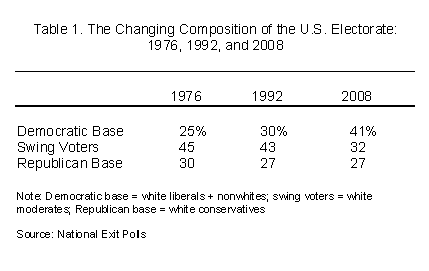
A growing number of political scientists, analysts and strategists are making the case for a realignment of political power in the U.S. to a new Democratic majority based on two trends: 1) the increasing numbers of black and Hispanic voters, and 2) a decisive shift away from the Republican Party by the suburban and well-educated constituencies that once formed the backbone of the GOP.
Arguments supporting a Democratic realignment are based on well-researched population and voting data. Nonetheless, at a time when the economy remains in crisis and when international tensions are intensifying across the globe, any claim that Democratic (or Republican) ascendance is inevitable should be viewed with caution.
In a March, 2009 51-page paper [PDF] "New Progressive America: Twenty Years of Demographic, Geographic, and Attitudinal Changes Across the Country Herald a New Progressive Majority," Ruy Teixeira makes a strong case that "progressive arguments are in the ascendancy," that demographic and geographic "trends should take America down a very different road than has been traveled in the last eight years. A new progressive America is on the rise."
To further buttress his case, Teixeira has put together "a very cool interactive mapthat includes 7 levels of exit poll demographics and county-level vote shifts going back to 1988."
Teixeira is by no means alone. The New Republic's John Judis, who collaborated with Teixeira on the 2001 book The Emerging Democratic Majority, wrote an article titled "America The Liberal" the day after the November 4, 2008, election. Judis made a similarly well-argued case that the election of Obama "is the culmination of a Democratic realignment that began in the 1990s. ... The country is no longer 'America the conservative.' And, if Obama acts shrewdly to consolidate this new majority, we may soon be 'America the liberal'."
On April 9, 2009, Emory political scientist Alan Abramowitz published a paper arguing that Obama's victory "was made possible by long-term changes in the composition of the American electorate, especially the growing voting power of African-Americans, Hispanics, and other nonwhites. As a result of these demographic changes, the Democratic Party enjoys a large advantage over the Republican Party in the size of its electoral base -- an advantage that is almost certain to continue growing for the foreseeable future."
All three authors make overlapping and similar cases.
Teixeira, for example, found that in many of the fastest growing sections of the country -- including metropolitan Las Vegas, Orlando, Florida, and Virginia's northern suburbs -- Obama's margin was an extraordinary 35 to 48 points higher than Dukakis' was 20 years earlier. He concluded that "where America is growing, progressives are gaining strength and gaining it fast."
Teixeira noted that pro-Democratic minorities have, over the same 20 years, grown from 15 to 28 percent of the electorate.
Judis demonstrated that professionals have gone from a solidly pro-Republican constituency to favoring Obama by a 58-40 margin. They have also grown from seven percent of the electorate in the 1950s to a solid 25 percent of voters in 2008.
Abramowitz presented a series of tables to back up his case:

Teixeira, Judis, Abramowitz and others all back up their analyses with census data and other statistics. It is difficult to dispute Teixeira's assertion that "a new progressive America has emerged with a new demography, a new geography, and a new agenda."
From the Republican vantage point, no scenario could be better: an adversary comfortable in victory is an adversary vulnerable to defeat. After the election of 1992, many analysts -- and even many Republicans -- were convinced that Bill Clinton had cracked the Republican lock, and that conservative hegemony was at an end.
"There is no doubt that current demographic trends favor the Democrats, based on the voting preference of those demographic groups in the last election," Republican pollster Whit Ayres conceded.
But, Ayres added, "why has virtually every past prediction of a 'permanent Republican majority' or an 'emerging Democratic majority' or a 'Republican lock on the Electoral College' been proven wrong? Because those predictions are invariably based on linear projections from recent elections, and they underestimate the parties' and politicians' ability to adapt to new realities."
"Republicans had a lock on southern electoral votes, until Clinton and then Obama figured out a way to pick the lock. Democrats had a lock on the west coast, until Arnold [Schwarzenegger] figured out a way to pick the lock.
Democrats look like they have a lock on Asian and Hispanic voters, at the moment. But Republicans are looking at the same trends as Ruy [Teixeira], and we will figure out a way to broaden our appeal to those groups. Just like in economic markets, there is a self-correcting mechanism in our politics. Losing is a wonderful corrective when either party gets too far from the mainstream."
Teixeira told the Huffington Post that conservative domination from the late 1960s to the turn of the century only provides support for his argument.
"There were some real demographic trends that helped produce the rise of conservatism -- a growing middle class that was less dependent on unionized, blue-collar jobs; the movement of whites, especially working-class whites, to the suburbs in search of order, security, and living space; the increasing population of the Sunbelt and so on -- but there was also, and related to those demographic shifts, big changes in the voting preferences of key groups, first and foremost, the white working class. The shift of these voters to the conservatives was central to the rise of conservatism.
This is typically the way it is -- there are not only demographic trends that affect the size of different groups, but shifts within those groups in how they behave. Both are relevant to explaining big political changes and both can have durable effects. That was true of the rise of conservatism and it is true of the current rise of progressivism.
Asked about the potential for a conservative reemergence, Teixeira responded:
As for conservatives being able to come back by making gains among some other group besides the white working class, this is certainly possible and I assume they will try to do that. The problem at the moment is they have nothing much to sell at this point that the rising demographic groups and areas are interested in buying. And they still seem pretty far away from recognizing that fact. But eventually they will, which should lead to some modernization of their program and jettisoning of outdated ideology....But this could take a while. In the meantime, the long-term shifts I talked about in the report should continueto advantage the progressive side of American politics."
Judis told the Huffington Post that "The only circumstances that could bring back the Republicans is Obama's failure to stem the recession."
"Obama does have to succeed, and so far, he's pretty much on the right track, and the Republicans are definitely not. That suggests to me that he and the Democrats will be able to solidify their majority in 2010 and 2012," Judis said. "But again, I don't fully understand what is going on in the world, and events could defy demography."
Perhaps the strongest evidence in support of the Teixeira-Judis-Abramowitz thesis is, however, the current inability of the Republican Party to respond to market pressures. Defeat has, ironically, diminished the GOP's capacity to respond to loss. As the elected leadership gets smaller, the strength of the most dogmatically rigid and least elastic faction has grown. On issues running the gamut from immigration to the economy, this dominant faction has yet to demonstrate "a wonderful corrective" in reaction to losing. Instead, they have retreated further inside an ideological shell that began to show cracks -- Bush I in '92, Dole in '96, and Bush v. Gore -- well over a decade ago.